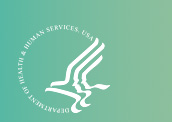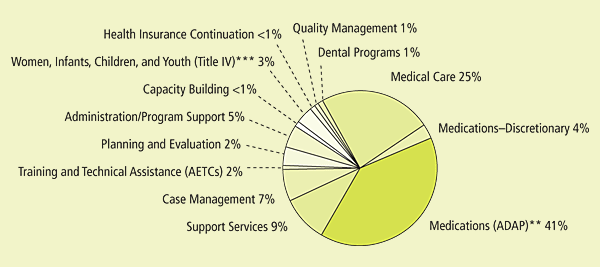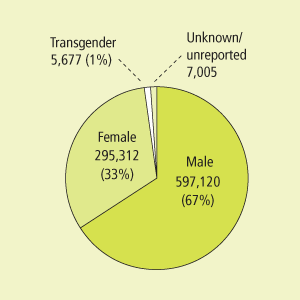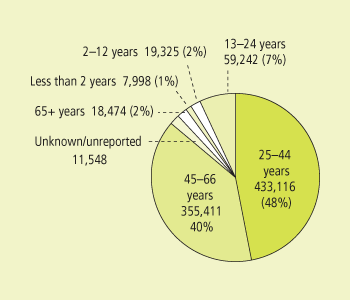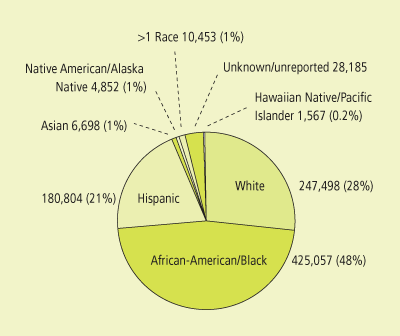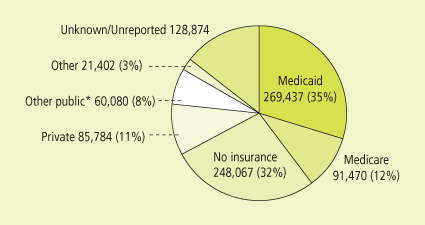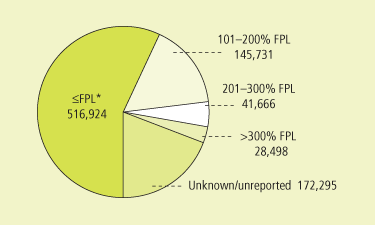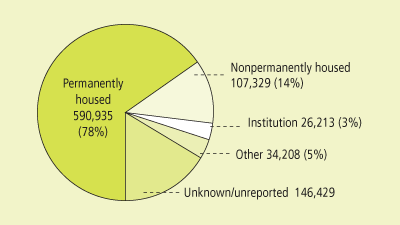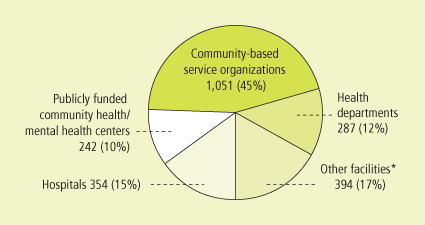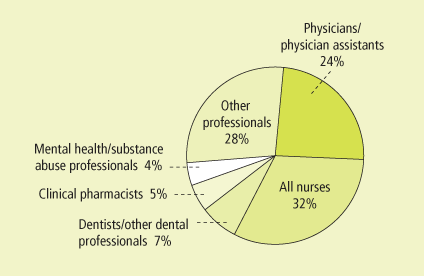What the Data Tell Us
The quest for improved HIV data is nothing new. The Ryan White HIV/AIDS Program is consistently fine-tuning the way in which data are managed and optimized. The more that we know about the services we are providing, who we are reaching, and how we are managing the care we offer, the better we are at providing care to those who need it most.
The data show that the Ryan White community has successfully been reaching the populations it has been charged to reach. It is enrolling people disproportionately affected by HIV disease—the under- and uninsured, the poor, ethnic and racial minorities, women, and people of all ages. As we move forward, we renew our commitment to improving the quality of our data and using it, in turn, to continue to improve the quality of HIV care that we are able to provide. And better care means better health and better lives for people living with HIV/AIDS.
CARE ACT SPENDING* FY 2006, N = 1.93 billionSource: HRSA HIV/AIDS Bureau. Allocation and
expenditure reports, 2006. 2006. [Unpublished data].
*Spending data in this chart are
based in part on planned spending reported by grantees.
**Approximately 4 percent of Medications (ADAP) spending was for health insurance
and adherence support.
***Title IV program reflects only a portion of spending for Women, Infants,
Children, Youth, and Families.
Percentages may not sum to 100 due to rounding. Unknown or unreported responses
are not included in percentage calculation.
Duplicated Ryan White HIV/AIDS Program Clients 2006, N = 905,114
Source: HRSA HIV/AIDS Bureau. 2006 CARE Act
data report. 2008. Table 1.
[In press]. Percentages may not sum to 100 due to rounding.
Unknown or unreported responses are not included in percentage calculation.
Duplicated Ryan White HIV/AIDS Program Clients 2006, N = 905,114
Source: HRSA HIV/AIDS Bureau. 2006 CARE Act
data report. 2008. Table 1.
[In press]. Percentages may not sum to 100 due to rounding.
Unknown or unreported responses are not included in percentage calculation.
Duplicated Ryan White HIV/AIDS Program Clients 2006, N = 905,114
Source: HRSA HIV/AIDS Bureau. 2006 CARE Act
data report. 2008. Table 1.
[In press]. Percentages may not sum to 100 due to rounding.
Unknown/unreported responses are not included in percentage calculation.
Ryan White HIV/AIDS Program Clients
2006, N = 905,114
Source: HRSA HIV/AIDS Bureau. 2006 CARE Act
data report. 2008. Table 3.
[In press]. *Includes State-funded plans, military health care (TRICARE/CHAMPUS),
or care provided by the U.S. Department of Veteran Affairs (VA), Veterans
Health Administration, the State Children’s Health Insurance Program, and
the Indian Health Service. Percentages may not sum to 100 due to rounding.
Unknown/unreported responses are not included in percentage calculation.
Ryan White HIV/AIDS Program Clients
2006, N = 905,114
Source: HRSA HIV/AIDS Bureau. 2006 CARE Act
data report. 2008. Table 2.
[In press]. *FPL = Federal Poverty Level. Percentages may not sum to 100
due to rounding. Unknown/unreported responses are not included in percentage
calculation.
Ryan White HIV/AIDS Program Clients
2006, N = 905,114
Source: HRSA HIV/AIDS Bureau. 2006 CARE Act
data report. 2008. Table 2.
[In press]. Percentages may not sum to 100 due to rounding.
Unknown/unreported responses are not included in percentage calculation.
Ryan White HIV/AIDS Program
2006, N = 2,328
Source: HRSA HIV/AIDS Bureau. 2006 CARE Act
data report. 2008. Table 4.
[In press]. Data on provider type were missing for 2 providers in 2006. *Includes
substance abuse treatment centers, solo/group private medical practices,
providers reporting for multiple fee-for-service providers, coalitions
of people living with HIV/AIDS, VA facilities, and provider type reported
as ‘other’. Percentages may not sum to 100 due to rounding.
Most Common Professions
2007, N = 73,157

